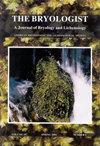Lichen saxicolous communities on granite churches in Galicia (NW Spain) as affected by the conditions of north and south orientations
IF 1.5
4区 生物学
Q4 PLANT SCIENCES
引用次数: 2
Abstract
Abstract. Lichens constitute the largest organisms among the stone colonisers. Several studies have shown that lichen species and their traits respond to environmental changes, but none of them focused on saxicolous communities. Five granite Galician churches were studied to characterize the lichen saxicolous communities established in the four façades. In four of the churches two climatic stations were placed, on the N and the S façades. Sampling was also more systematic on N and S walls, as these tend to show the most extreme microclimatic characteristics: relatively cool and humid in the N vs. warm and dry in the S. We aimed at identifying the species and traits associated with these conditions, so as to predict the possible evolution over time in these communities in the prospect of further climate warming in the future. Climatic data were subjected to two-way analyses of variance (ANOVA). We computed species accumulation curves and species richness estimators with EstimateS, analysed the effect of the church, the aspect (N vs. S) and the position of sampling squares on the number of lichen species and on lichen abundance, and community composition in terms of species and lichen traits. Richness analysis showed that only orientation had a significant effect on the number of species present on the walls. Lichen cover was always higher in the N, but the difference was not significant, and only the church factor had a significant effect. Taxa characterizing the N façades were the two varieties of Haematomma ochroleucum, Ochrolechia parella, together with the lichen species with Trentepohlia as photobiont. On the S façades, the characteristic species were Candelariella vitellina and Lepra leucosora; there was a higher diversity of biotype, size and color; with a total absence of sorediate species or with Trentepohlia as photobiont. There was a clear difference between the lichen species requirements in sunlight and aridity on the N and S façades. We hypothesize that a warmer and more arid climate may result in an expansion of the S-dominant lichen species and/or lichen traits to the detriment of those N-dominant.加利西亚(西班牙西北部)花岗岩教堂上的Lichen-saxicolous社区受到南北方向条件的影响
摘要地衣是石头殖民者中最大的生物。一些研究表明,地衣种类及其性状对环境变化有响应,但没有一项研究集中在沙生群落。研究了五个花岗岩加利西亚教堂,以确定在四个faalades建立的地衣萨奇群落的特征。在其中的四座教堂里,设置了两个气候站,分别位于北纬和南纬。在北侧和南侧壁上的采样也更为系统,因为这些壁上往往表现出最极端的小气候特征:北侧相对凉爽潮湿,南侧温暖干燥。我们的目标是确定与这些条件相关的物种和特征,从而预测这些群落在未来进一步气候变暖的情况下可能随着时间的推移而演变。气候数据进行了双向方差分析(ANOVA)。利用estimators计算物种积累曲线和物种丰富度,分析了教堂、样方向(N vs. S)和样方位置对地衣物种数量和地衣丰度的影响,以及地衣物种和地衣性状的群落组成。丰富度分析表明,只有朝向对壁上存在的物种数量有显著影响。地衣盖度在N条件下均较高,但差异不显著,只有教会因子有显著影响。其中以红血肿(Haematomma ochroleucum)、红血肿(ocholechia parella)两个变种和以绿血肿(Trentepohlia)为光生物的地衣物种为特征。在南区,特征种为黄烛菌(Candelariella vitellina)和Lepra leucosora;在生物型、大小和颜色上有较高的多样性;完全没有单独的物种或以光生物为光生物的Trentepohlia。地衣种类对阳光和干旱的需求在南北缘有明显差异。我们推测,气候变暖和干旱可能导致s优势地衣物种和/或地衣性状的扩张,而n优势地衣物种和/或地衣性状则受到损害。
本文章由计算机程序翻译,如有差异,请以英文原文为准。
求助全文
约1分钟内获得全文
求助全文
来源期刊

Bryologist
生物-植物科学
CiteScore
2.40
自引率
11.10%
发文量
40
审稿时长
>12 weeks
期刊介绍:
The Bryologist is an international journal devoted to all aspects of bryology and lichenology, and we welcome reviews, research papers and short communications from all members of American Bryological and Lichenological Society (ABLS). We also publish lists of current literature, book reviews and news items about members and event. All back issues of the journal are maintained electronically. The first issue of The Bryologist was published in 1898, with the formation of the Society.
Author instructions are available from the journal website and the manuscript submission site, each of which is listed at the ABLS.org website.
All submissions to the journal are subject to at least two peer reviews, and both the reviews and the identities of reviewers are treated confidentially. Reviewers are asked to acknowledge possible conflicts of interest and to provide strictly objective assessments of the suitability and scholarly merit of the submissions under review.
 求助内容:
求助内容: 应助结果提醒方式:
应助结果提醒方式:


